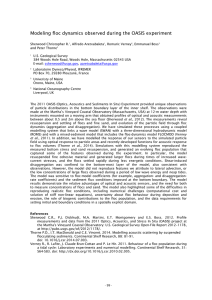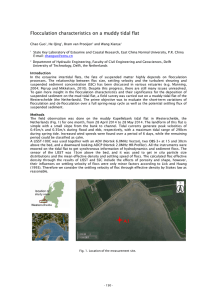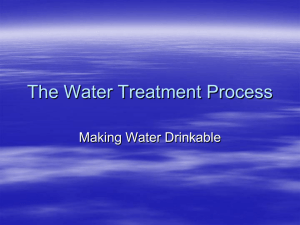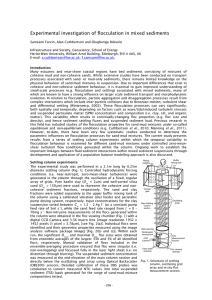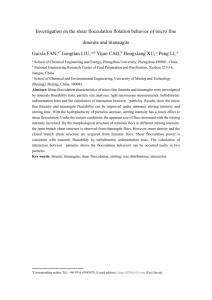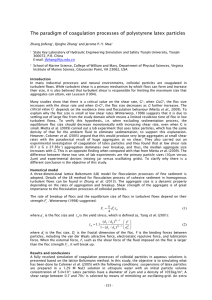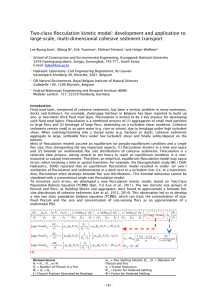Bhadbhade revised proposal
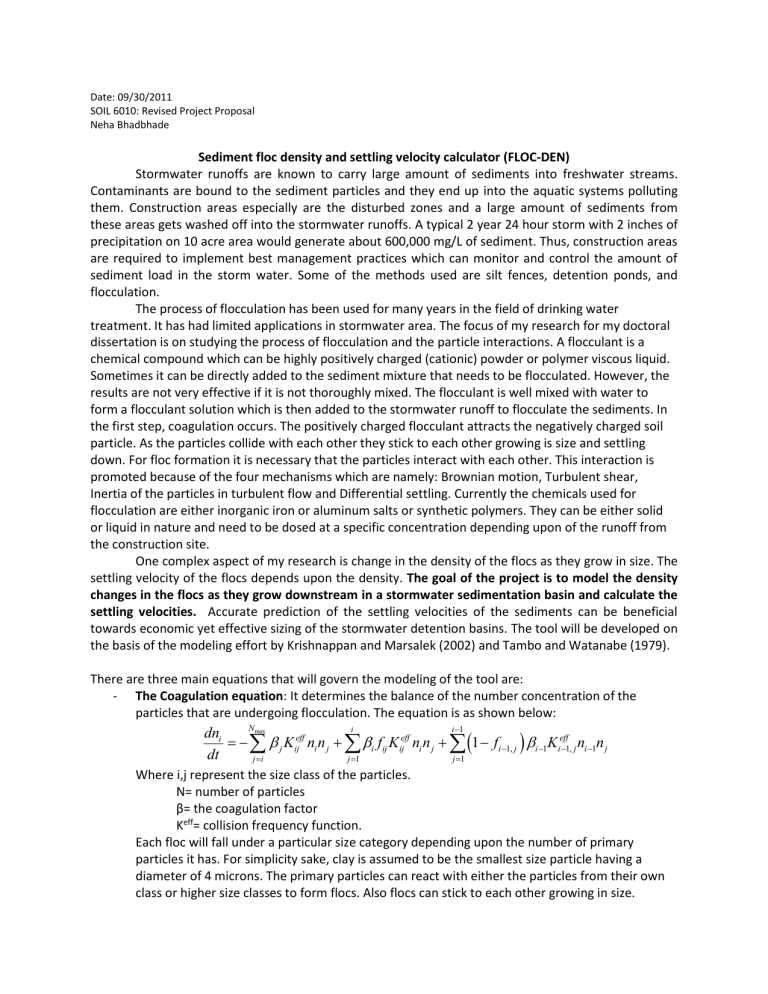
Date: 09/30/2011
SOIL 6010: Revised Project Proposal
Neha Bhadbhade
Sediment floc density and settling velocity calculator (FLOC-DEN)
Stormwater runoffs are known to carry large amount of sediments into freshwater streams.
Contaminants are bound to the sediment particles and they end up into the aquatic systems polluting them. Construction areas especially are the disturbed zones and a large amount of sediments from these areas gets washed off into the stormwater runoffs. A typical 2 year 24 hour storm with 2 inches of precipitation on 10 acre area would generate about 600,000 mg/L of sediment. Thus, construction areas are required to implement best management practices which can monitor and control the amount of sediment load in the storm water. Some of the methods used are silt fences, detention ponds, and flocculation.
The process of flocculation has been used for many years in the field of drinking water treatment. It has had limited applications in stormwater area. The focus of my research for my doctoral dissertation is on studying the process of flocculation and the particle interactions. A flocculant is a chemical compound which can be highly positively charged (cationic) powder or polymer viscous liquid.
Sometimes it can be directly added to the sediment mixture that needs to be flocculated. However, the results are not very effective if it is not thoroughly mixed. The flocculant is well mixed with water to form a flocculant solution which is then added to the stormwater runoff to flocculate the sediments. In the first step, coagulation occurs. The positively charged flocculant attracts the negatively charged soil particle. As the particles collide with each other they stick to each other growing is size and settling down. For floc formation it is necessary that the particles interact with each other. This interaction is promoted because of the four mechanisms which are namely: Brownian motion, Turbulent shear,
Inertia of the particles in turbulent flow and Differential settling. Currently the chemicals used for flocculation are either inorganic iron or aluminum salts or synthetic polymers. They can be either solid or liquid in nature and need to be dosed at a specific concentration depending upon of the runoff from the construction site.
One complex aspect of my research is change in the density of the flocs as they grow in size. The settling velocity of the flocs depends upon the density. The goal of the project is to model the density changes in the flocs as they grow downstream in a stormwater sedimentation basin and calculate the
settling velocities. Accurate prediction of the settling velocities of the sediments can be beneficial towards economic yet effective sizing of the stormwater detention basins. The tool will be developed on the basis of the modeling effort by Krishnappan and Marsalek (2002) and Tambo and Watanabe (1979).
There are three main equations that will govern the modeling of the tool are:
The Coagulation equation: It determines the balance of the number concentration of the particles that are undergoing flocculation. The equation is as shown below: dn i dt
N max eff
K n n j ij i j
i j
1
eff f K n n i ij ij i j
i j
1
1
1
f i
1, j
i
1
K i eff
1, j n n i 1 j
Where i,j represent the size class of the particles.
N= number of particles
β= the coagulation factor
K eff = collision frequency function.
Each floc will fall under a particular size category depending upon the number of primary particles it has. For simplicity sake, clay is assumed to be the smallest size particle having a diameter of 4 microns. The primary particles can react with either the particles from their own class or higher size classes to form flocs. Also flocs can stick to each other growing in size.
Equation to determine the density of flocs
The density of the flocs will be estimated from number concentration of the primary particles in each floc, the volume of the floc and the volume of the internal water that the floc contains.
From the research work done by Krishnappan and Marsalek (2002) the equation to determine the density of the flocs is given as below:
w
s ,1 exp
bd i c
Where ρ s,i
= density of the floc (kg/m 3 )
ρ w
= density of water (kg/m 3 )
ρ s,1
= density of primary particle (kg/m 3 )
d i
= diameter of the i class particle (m)
b and c are empirical constants. b=0.02 and c=1.45. These constants will be tested to see if they fit in the existing experimental data. Optimization routine will be run if they require calibration.
Stokes Law for settling velocity of the particles:
The equation for the settling velocity of the particles is as shown below: 𝒗 𝒔
=
𝟐 (𝝆 𝒇
−𝝆 𝒘
)
𝟗 𝝁 𝒈𝑹
𝟐
Where v s
= settling velocity (m/sec)
ρ f
=density of floc (kg/m 3 )
ρ w
= density of water (kg/m 3 )
µ=dynamic viscosity of water (N-s/m 2 ) g= acceleration due to gravity (m/sec 2 )
R= radius of the floc
The bulk density of the soil is determined using soil texture triangle. Sizes of the flocs are measured using laser techniques and high speed imaging devices. The floc size and density relationship was first modeled by Lagvankar and Gemmell (1968). Since then a number or researchers have tried to model flocculation. However, in the field of sedimentation engineering, there is no tool which can help in sizing the sedimentation basin based on floc density relations. This tool can be used by stormwater practitioners and consultants to calculate the detention time and the size of the detention ponds and also estimate the sediment load in the stormwater runoff. It can be useful to students and professors in the working in the field of sedimentology as a quick reference guide to determine the settling characteristics of different soils and aggregates.
References:
Krishnappan B.G, Marsalek J. 2002. Modeling of flocculation and transport of cohesive sediment from an on-stream stormwater detention pond. Water Research, 36 (2002)3849-3859.
Tambo N, Watanabe Y. Physical aspect of flocculation process—I. Fundamental treatise. Water Res
1979; 13:429–39.
Lagvanker.A.L, Gemmell, R.S, 1968. A size-density relationship for flocs: J. Am. Water Works
Assoc.,p.1040-1046 soc., p. 1040-1046.
